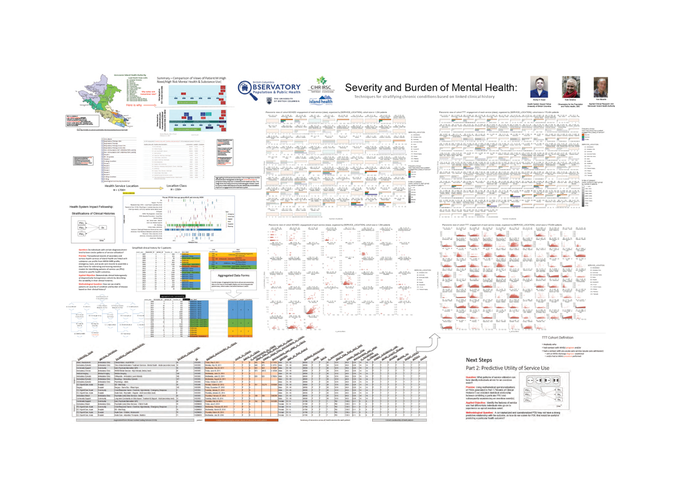Severity and Burden of Mental Health
Techniques for stratifying chronic conditions based on linked clinical history

Severity and Burden of Mental Health
Techniques for stratifying chronic conditions based on linked clinical history
Abstract
Using cross-continuum implementation of clinical records at Vancouver Island Health Authority we demonstrate a set of analytical techniques supporting empirical stratification of diagnostically homogeneous cohorts based on severity of condition and burden to the service system. We visualize the variability in clinical histories of patients with confirmed diagnosis of (1) schizophrenia and (2) bipolar disorders.
Poster presented at the 2018 conference of the Canadian Association for Health Services and Policy Research, Montreal, Quebec.

Objective
Using cross-continuum implementation of clinical records at Vancouver Island Health Authority we demonstrate a set of analytical techniques supporting empirical stratification of diagnostically homogeneous cohorts based on severity of condition and burden to the service system. We visualize the variability in clinical histories of patients with confirmed diagnosis of (1) schizophrenia and (2) bipolar disorders.
Approach
The linked data model includes three components. (1) The records of encounters with secondary and tertiary services provide a time-stamped tape of clinical events, in the context of which other clinical information can be interpreted. (2) Diagnostic profiles come from emergency and acute care administrative sources (National Ambulatory Care Reporting System (NACRS) and Diagnosis Abstract Database (DAD), respectively). (3) Substance use and psychiatric profiles come from the Ministry of Health’s Minimum Reporting Requirements (MRR) for Mental Health and Substance Use (MHSU) conditions. We train statistical models to detect consistent patterns of service use (PSU) forming the basis for stratification mechanism.
Results
We organize our data methods according to the guidelines of reproducible research, a technical enabler of a learning healthcare system. We present a series of information displays demonstrating clinical heterogeneity of diagnostically homogeneous cohorts by describing the variability in their clinical histories. We demonstrate how we operationalize PSUs related to (1) the rate of emergency department encounters (2) number of days spent in acute care and (3) the rate of engaging laboratory services. We employ these quantifications of severity and burden to compare and contrast clinical journeys of two diagnostically homogeneous groups: patients with schizophrenia and patients with bipolar disorder.
Conclusions
We can better understand the experiences of patients with chronic mental health conditions if we examine patients’ journeys through the healthcare system in the context of linked clinical history. Patterns of service use and clinical profiles are effective tools for empirical stratification of severity and burden among patients with schizophrenia and bipolar disorders.